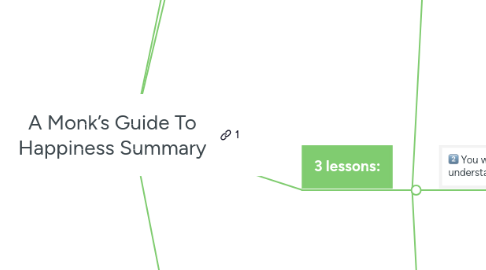
1. 1-Sentence-Summary:
1.1. A Monk’s Guide To Happiness will help you find more joy in life by identifying the mental pitfalls you fall into that make it so hard to have and how to shatter the shackles of suffering to finally find inner peace.
2. Favorite quote from the author:
2.1. "Our natural state is to feel good - we are built for happiness." - Gelong Thubten
3. 3 lessons:
3.1. Knowing what happiness consists of is the first step in the journey to finding more joy.
3.1.1. “If you are depressed you are living in the past. If you are anxious you are living in the future. If you are at peace you are living in the present.” - Lao Tzu
3.1.1.1. The keyword in the quote is living in the present, which is the sweet spot where happiness exists.
3.1.2. Thubten teaches us that there are three components to happiness now:
3.1.2.1. Fullness
3.1.2.1.1. When we recognize that we don’t need anything to be content, we feel fullness, which makes us happy. It’s a feeling of contentment with who we are and what we have, right now.
3.1.2.2. Anchoring to the present
3.1.2.2.1. Getting an anchor to the present involves staying focused on the here and now.
3.1.2.2.2. We don’t need to get caught up in past failures or future worries.
3.1.2.3. Freedom
3.1.2.3.1. Freedom is the feeling of liberation from every source of unhappiness.
3.1.2.3.2. This involves not letting our negative emotions hold us hostage.
3.2. You will have more enjoyment in life if you understand what you do that takes it away.
3.2.1. Whenever we uncover the roadblocks in our way to something we want, we set ourselves up for success.
3.2.2. Whenever we’re feeling down, it’s because of three mentalities:
3.2.2.1. Incompleteness
3.2.2.2. Being mentally removed from the present
3.2.2.3. Confinement
3.2.3. These attitudes come from wanting things that we don’t have but that we think we can’t be happy without.
3.2.4. Let’s say you’re looking to get a promotion at work, for example. You don’t have it yet, but you somehow think that getting it will make you happy.
3.2.4.1. This gives you a feeling of incompleteness.
3.2.5. This comes from the incorrect assumption that you can find happiness outside of yourself and in some future occurrence instead of now.
3.2.6. It doesn’t matter if you’re trying to get something material or an experience or achievement, wanting what you don’t have makes you unhappy.
3.2.7. It’s also a problem because it locks your happiness up by putting it in the hands of circumstances that you have no control over.
3.2.7.1. In the case of your promotion, for example, no matter how well you do it’s still up to your boss whether or not you get it.
3.2.7.2. And even if you do end up getting it, your satisfaction won’t last long. Soon you’ll be habitually looking to the next thing that you think will make you happy.
3.3. Meditation is the pathway to inner peace and contentment, and you can develop it with daily practice in any situation.
3.3.1. Meditation does a perfect job of helping us experience fullness, freedom, and anchoring to the present.
3.3.2. All it takes is three simple steps:
3.3.2.1. Find something in the present to anchor your mind to.
3.3.2.1.1. The easiest way to practice the first step is to anchor your mind to your breath.
3.3.2.1.2. It helps to count the breaths up to 10, then start over.
3.3.2.2. Notice whenever your mind wanders.
3.3.2.2.1. It’s important to remember that your mind is going to stray. When this happens, you simply need to recognize it without judgment.
3.3.2.3. Softly bring your thoughts back to your anchor.
3.3.2.3.1. It’s normal to think about other things when you’re meditating, but you do want to bring your mind back to the present.
3.3.3. You can try this with actions you already do, like brushing your teeth.
3.3.3.1. Anchor your mind to the taste or sounds.
3.3.3.2. Then when your thoughts wander, observe that it’s happened and gently get it back on track.
